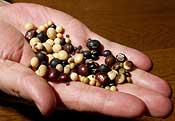|
Breeding soybeans for greater potential |
Fayetteville, Arkansa
February 6, 2003
- By Fred Miller, Science Editor
- Arkansas Agricultural Experiment
Station
-
fmiller@uark.edu
-
- Got soy?
From tofu to soy milk, Pengyin Chen believes there's a lot of
room for growth in niche markets for soybeans, and he's working
hard at the Arkansas Agricultural Experiment Station to make
sure Arkansas farmers can claim a place in the industry.
|
Chen, University of Arkansas
Division of Agriculture soybean breeder, is combing the USDA
soybean germ plasm collection for material he can use to breed
specialized beans adapted to Arkansas.
"Japan is the largest importer of U.S. food-grade soybeans,
buying more than 50 million bushels annually," Chen said. "In
America, soybean consumption is growing as people become aware
of the health benefits and nutritional value, including high
protein, calcium and fiber content. Growing demand for
soybeans are creating opportunities for producers to get
higher prices for specialized beans."
Chen spends most of his time on improving conventional
varieties for Arkansas' mainstream soybean production. But he
believes the additional time he devotes to specialized
soybeans could yield extra profit for producers looking for
opportunities in niche markets.
Using conventional crossbreeding techniques, Chen has
produced breeding lines of soybeans that are twice the size of
typical U.S.-grown beans, and other lines that are half the
size. "The larger soybeans are preferred for products such as
tofu, miso (a paste made from soybean and rice), soy nuts and
soy milk," he said. "The smaller beans are desired for making
natto (a Japanese food made of fermented soybeans) and bean
sprouts."
He harvested these breeding lines in 2002 and will make
selections for advanced lines to be planted this year. Among
the traits he's looking for in advanced lines are yields
comparable to the traditional soybeans producers are used to.
"I've matched yields for the larger soybeans," he said.
"The smaller soybeans are producing smaller yields, but
they're up to about 90 percent of typical yield for Arkansas
soybeans."
|
 |
|
UA
soybean breeder Pengyin Chen is using the diversity of
available soybean germplasm to develop specialized soybeans
that can be grown in Arkansas for niche markets.
|
 |
|
Samples
of soybeans from the USDA germplasm collection show some of
the variety of colors and sizes available to soybean breeders.
|
Other challenges for developing specialized soybeans
include selections for appropriate maturity, disease
resistance, and resistance to lodging and shattering. He's
also working on varying color (chocolate-colored beans, for
example, are desirable for soy nuts), increasing protein
content and adjusting flavor to match Western tastes.
"We know the genes that produce the 'beanny' flavor
preferred in the Orient, but disliked in Western cultures,"
Chen said. "By reducing this flavor and increasing the
sucrose content, to produce a sweeter bean, we can develop a
specialty bean for soy products that suit American tastes."
Such specialty soybeans will be suitable for relatively
small markets that will demand organically-produced products
that are not genetically-modified. "They'll require greater
care on the part of producers, but they'll demand higher
prices than conventional soybeans," he said.
|
|